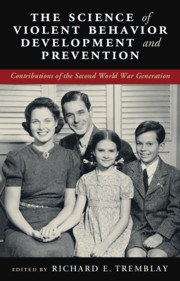 The Science of Violent Behavior Development and Prevention
The Science of Violent Behavior Development and Prevention Book contents
- The Science of Violent Behavior Development and Prevention
- The Science of Violent Behavior Development and Prevention
- Copyright page
- Contents
- Preface
- 1 Introduction: A Young Science with a Long History
- 2 From Birth in a British Orphanage to Assessments of American Indians’ Development
- 3 From Rationing, Illness, and Stress to the Creation of a Major Longitudinal Birth Cohort
- 4 From Country Girl in Southern Finland to Longitudinal Research into Alternatives to Aggression and Violence
- 5 From the Occupied Netherlands to the Pittsburgh Longitudinal Studies
- 6 From Boy to Man
- 7 Nurture and Nature
- 8 From Unruly Child to Political Protester and Promoter of an Ecology-Minded Concept of Development
- 9 From the Frustration–Aggression Hypothesis to Moral Reasoning and Action
- 10 A Tortuous Path towards Understanding and Preventing the Development of Chronic Physical Aggression
- 11 From Childhood in a Ruined German City to Research on Crime and Violence
- 12 The Last War Baby
- 13 Comments on the Autobiographies of the World War II Babies by Younger Peers
- Index
- References
9 - From the Frustration–Aggression Hypothesis to Moral Reasoning and Action
Published online by Cambridge University Press: 28 January 2021
- The Science of Violent Behavior Development and Prevention
- The Science of Violent Behavior Development and Prevention
- Copyright page
- Contents
- Preface
- 1 Introduction: A Young Science with a Long History
- 2 From Birth in a British Orphanage to Assessments of American Indians’ Development
- 3 From Rationing, Illness, and Stress to the Creation of a Major Longitudinal Birth Cohort
- 4 From Country Girl in Southern Finland to Longitudinal Research into Alternatives to Aggression and Violence
- 5 From the Occupied Netherlands to the Pittsburgh Longitudinal Studies
- 6 From Boy to Man
- 7 Nurture and Nature
- 8 From Unruly Child to Political Protester and Promoter of an Ecology-Minded Concept of Development
- 9 From the Frustration–Aggression Hypothesis to Moral Reasoning and Action
- 10 A Tortuous Path towards Understanding and Preventing the Development of Chronic Physical Aggression
- 11 From Childhood in a Ruined German City to Research on Crime and Violence
- 12 The Last War Baby
- 13 Comments on the Autobiographies of the World War II Babies by Younger Peers
- Index
- References
Summary
Gian Vittorio Caprara was born in Italy in 1944. He is Emeritus Professor in Psychology at the University of Rome and was also a fellow at the Netherlands Institute for Advanced Study and at the Swedish Collegium for Advanced Study. He founded the Interuniversity Center for the Study of Prosocial and Antisocial Motivation in Italy. He studied three major topics – personality, aggression, political preferences and participation – with an interactionist and social cognitive approach in which personality is considered a self-regulatory system while biological potential is mostly conditioned by culture. He initiated the Genzano Longitudinal Study, which followed 10-year-old children from elementary school through adolescence. The study focused on the development of aggression and prosocial behavior; stability and change in personality; the determinants of academic achievement and vocational choices; family and romantic relations; and civic and political behavior. The study investigated how different aspects of personality operate in concert. The aim was to clarify pathways that lead to maladjusted and risky behaviors. The findings led to the development of a theory that assigns to marginal deviations from normative behaviors a crucial role in the development of maladjusted behavior. The study also led to psychosocial interventions promoting and sustaining healthy development.
Keywords
- Type
- Chapter
- Information
- The Science of Violent Behavior Development and PreventionContributions of the Second World War Generation, pp. 215 - 240Publisher: Cambridge University PressPrint publication year: 2021
